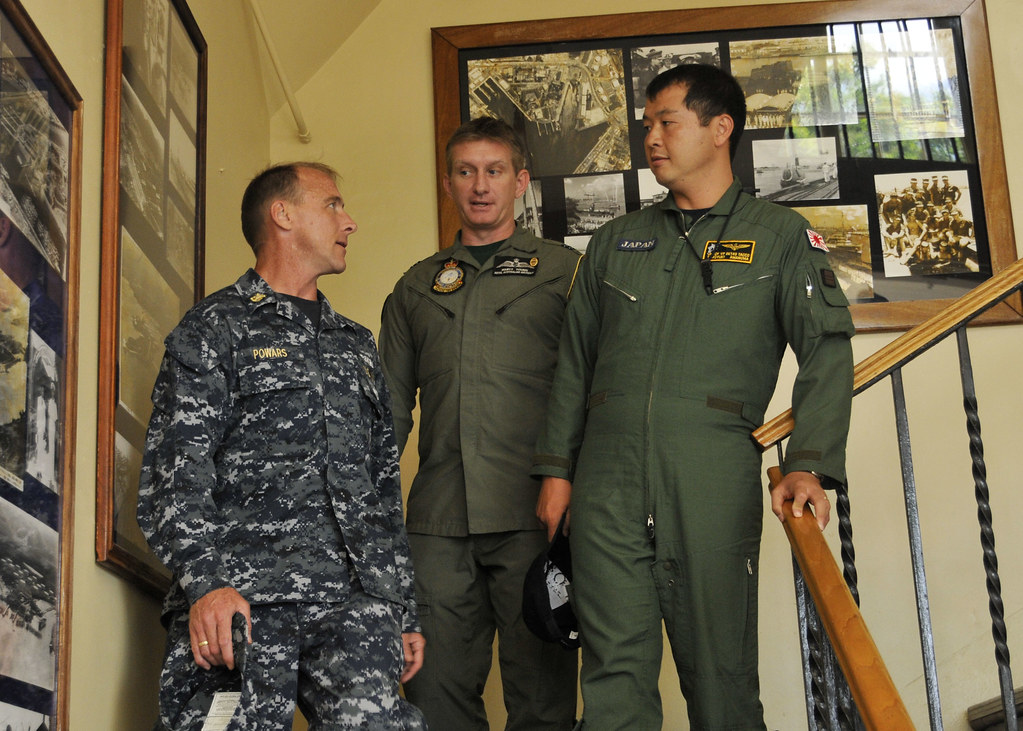By MC1 Jason Swink,
Submarine Force Pacific Public Affairs
<< JOINT BASE PEARL HARBOR-HICKAM, Hawaii - (July 25, 2014) - Rim of the Pacific (RIMPAC) exercise participants Command Master Chief Adam Powars of undersea warfare operations, left, Flight Lt. Marty Young, future operations watch officer of Command Task Force (CTF) 174 for the Royal Australian Air Force, and Lt. Cmdr. Tomoyuki Amanuma, liason naval officer for the Japan Maritime Self Defense Force, discuss operations for the exercise on Joint Base Pearl Harbor-Hickam, July 25. (U.S. Navy Photo by Mass Communication Specialist 1st Class Steven Khor/Released)
(PEARL HARBOR, Hawaii) – Rim of the Pacific (RIMPAC) 2014 exercise provides Anti-Submarine Warfare Force 3rd Fleet (CTF-34) the opportunity to bring together a cooperative training environment for multinational anti-submarine warfare (ASW) June 26 through August 1.
Liaison Naval Officers (LNOs) from Australia, Republic of Korea, Canada and Japan stand watch with CTF-34 staff helping coordinate various air, surface and subsurface assets taking part in the complex task of multinational anti-submarine warfare.
"Theater ASW requires a team and teamwork, not only among the surface, air, and subsurface warfare communities, but also with our coalition partners," said Rear Adm. Phil Sawyer, commander of Submarine Force, U.S. Pacific Fleet.
"During RIMPAC, we have benefited tremendously from working with ASW forces from Australia, Canada, Chile, Japan, New Zealand, and the Republic of Korea, each of whom brings unique skills and perspectives to the table," said Sawyer. "Exercising together has improved interoperability and has allowed us to build enduring relationships that will pay dividends well into the future."
Japan Maritime Self Defense Force (JMSDF) LNO Lt. Cmdr. Tomoyuki Amanuma provides Maritime Patrol Reconnaissance Aircraft expertise while learning valuable interoperability and partnership concepts.
"The ability to work in coalitions is a very big deterrent to those who would use undersea warfare for aggression," said Amanuma. "Just one country or one navy cannot keep the peace for all nations. It is important for all nations to cooperate."
Royal Australian Navy LNO Lt. Martin Talbot appreciated the chance to rotate through various positions.
"It's all well and good to read about it in a publication," said Talbot. "To actually come here and see how it's done firsthand and see what the jobs do and how the various watch captains input into the whole scenario really ties in the publications and doctrines."
As with the overall RIMPAC exercise, the ASW portion provides an important training opportunity to enhance interoperability between participating forces, improve readiness and strengthen military-to-military partnerships.
Republic of Korea (ROK) LNO Lt. Jung Hoon Seo, who is participating in his first RIMPAC exercise, hopes more of his colleagues can participate in future exercises like RIMPAC, and continue to build relationships that add to the peace and stability to the region.
"Each of the nations' submarines operate differently and exercises like this help up us come to a better understanding of each other's intentions," said Seo.
"RIMPAC's theater anti-submarine warfare exercise is all about gaining experience; each different country brings a different set of skills," said Talbot. "So tying it all in internationally, we can take various bits of information from each country and come up with an international way of doing business."
Anti-submarine warfare is a core war-fighting skill used to counter any potential adversary submarine threat, and is a component of a large-scale maritime operation such as RIMPAC.
"It's very important, none of the surface ships can get to where they are going without the waters being clear of submarines, and that's what CTF-34 is all about," said Talbot.
The mission of CTF-34 is to execute theater anti-submarine warfare and fulfill a training support role to plan and conduct theater ASW exercises, providing tactical command and control of assigned ASW assets during operations and exercises.
Twenty-two nations, more than 50 ships and submarines, about 200 aircraft and 25,000 personnel are participating in Exercise RIMPAC in and around the Hawaiian Islands and Southern California. The world's largest international maritime exercise, RIMPAC provides a unique training opportunity that helps participants foster and sustain the cooperative relationships that are critical to ensuring the safety of sea lanes and security on the world's oceans. RIMPAC 2014 is the 24th exercise in the series that began in 1971.

